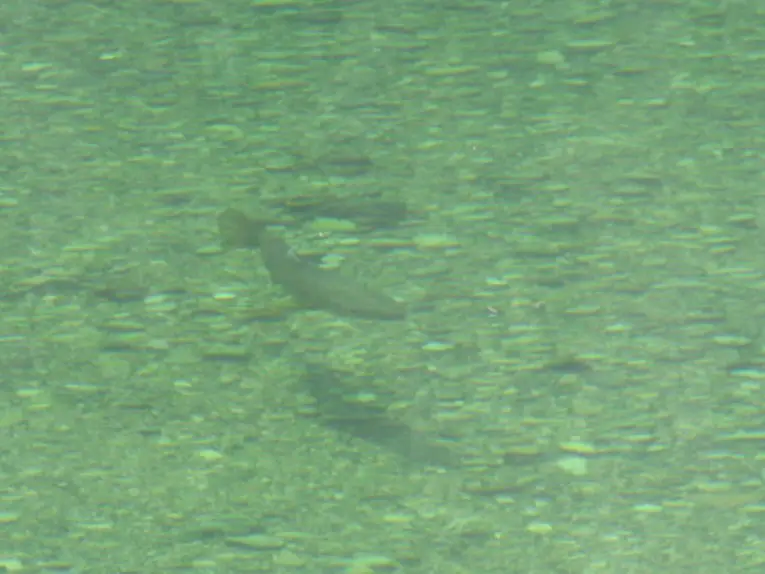Most anglers, myself included only fish the first few feet of most rivers and pools we fish. We cast out, maybe let the lure sink for a few seconds before starting our retrieve. The lure, unless it is a diving variant usually dances back toward the surface. Even most deep diving baits really only get down to 6-8feet, even less if there is a strong current.
For the fly fisherman, it is even more difficult, and most presentations using a floating line are within the first few feet. Changing over to a sinking line, and usually, heavily weighted flies do get down deeper, but in most cases, the streamer or nymph is still within a few feet of the surface.
Just how deep do trout hold?
Clear water is deceptively deep. On many occasions, I will look into a pool, and think it must only be 2-3 feet deep. I will wade out there before casting upstream to get a better drift. Wading out I quickly find the water will be up to my chest and the bottom of the pool deeper still.
This is just the ponds where I can see the pond, other times I approach pools that disappear into dark greenish blue depths. Just how deep are these ponds?
Will, on hot summer days, I sometimes don a mask and snorkel and dive on in. Depending on the size of river of course, but some of these pools are deep. I stand 6’4” and it is not uncommon to encounter pools threes times deeper than my height.
When I was younger, I use to do free diving, and could quite comfortably dive down to 30ft and have encountered a few pools pushing my limits to reach the bottom.
What do I find at the bottom? Well firstly, while the water on the surface could be a roaring current. Down at the bottom of the pool is quite calm.
What I usually find, are large groups of trout in all sizes ranges. The majority of which are only 1-3lb, but there is nearly always a couple of much bigger fish. Sometimes pushing double figures usually well hidden in the middle of the school.
When there is a sunken tree branch, I also often find an assortment of different fishing spoons. I rarely find flies, jerkbaits, or inline spinners. The reason why?
The above lures do not usually get deep enough to fish the bottom. If you want to fish the bottom of these pools, where trout often hold a spoon is typically the only lure that gets deep enough to consistently fish there.

What are the trout doing down there?
These trout are usually resting, and are rarely in the mood to feed. This is the reason why they constantly ignore all the lures and flies that dart across the water column well above.
The best way to catch such fish is to wait until they are in a feeding mood, then they will leave the deeps and usually feed closer to the surface.
Ever been to a trout river, and barely saw a fish, but once the hatch begins the water is boiling with them? Well, all of these trout were hiding in the depths or beneath overhangs. The hatching insects are an easy enough meal to get them into the mood to feed.
When trout do decide to feed, they nearly always move from the depths, into shallower water with more current. It is no secret, that a feeding fish is a lot easier to catch than a resting one.

How to catch a trout resting at the bottom of deep pool?
It is not always possible to wait until a trout is willing to feed. Sometimes we just want to catch fish now.
Well, the best way to catch such trout is to trick them to strike out of aggression.
The easiest way is probably to bounce a spoon across the bottom of their pool. If you can present the spoon in the trouts ‘personal space’ there is a reasonable chance
it will bite it out of anger. Then it is only a matter of striking at the right time to set the hook.
Now, different spoons have different specialties. Some cast better, some flutter better and some sink faster. When fishing deep, it is best to use a fast sinking spoon. They are typically a bit smaller and denser. Some popular brand names are Acme Little Cleo or the Eppinger Daredevle.
The ideal weight depends on both the water depth and speed of the current. Ideally, fish the smallest size which has enough mass to reach the bottom. 1/4oz is usually a good starting point.
Another option is to fish a large, deep sinking inline spinner. A good example is the Blue Fox Vibrax, cast upstream and give it plenty of time to sink. The slow retrieve making sure it stays near the bottom. The thumping sound generated by the rotating blade can really drive trout crazy.
How to catch resting trout on the fly rod?
I love fly fishing, but it is very challenging to get a fly deep enough to target such a trout. I have certainly wasted hours trying to get such trout to raise for nymphs or dries.
I personally resort to two tactics that seem to bring me the most success.
The first is when I am fishing my floating line, and just come across a deep pool which I know is holding trout. In desperation, I often tie on the biggest, most obnoxious looking weighted fly in my box and let it sink. Ideally, you will want as long a leader as you can comfortably cast.
Hopefully, it gets down deep enough to trigger a reaction. It is also possible to pinch on a couple of pieces of split shot for an even faster sinking rate. Now, keep in mind, at best such a presentation is only going to reach 5-6ft beneath the surface.
If you have more time to plan. I suggest using a fast sinking tip fly line. This combined with a weighted fly can get a streamer down to a more respectable depths. In saying that, due to the thickness of the fly line resulting in more drag, it is never going to get as deep as fast as a spinning spoon.

